
Reeve Aleutian Airways was an airline headquartered in Anchorage, Alaska, United States. It ceased operations on December 5, 2000. Reeve Aleutian was named, possibly as a pun on the word revolution, by combining founder Robert C. Reeve's surname and the Aleutian Islands, its primary destination.

The De Havilland Canada DHC-8, commonly known as the Dash 8, is a series of turboprop-powered regional airliners, introduced by de Havilland Canada (DHC) in 1984. DHC was bought by Boeing in 1986, then by Bombardier in 1992, then by Longview Aviation Capital in 2019; Longview revived the De Havilland Canada brand. Powered by two Pratt & Whitney Canada PW150s, it was developed from the Dash 7 with improved cruise performance and lower operational costs, but without STOL performance. The Dash 8 was offered in four sizes: the initial Series 100 (1984–2005), the more powerful Series 200 (1995–2009) with 37–40 seats, the Series 300 (1989–2009) with 50–56 seats, and Series 400 (1999–2022) with 68–90 seats. The QSeries are post-1997 variants fitted with active noise control systems.
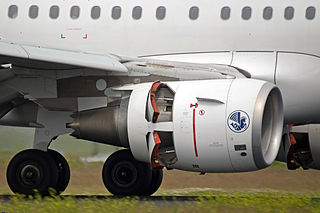
Thrust reversal, also called reverse thrust, is the temporary diversion of an aircraft engine's thrust for it to act against the forward travel of the aircraft, providing deceleration. Thrust reverser systems are featured on many jet aircraft to help slow down just after touch-down, reducing wear on the brakes and enabling shorter landing distances. Such devices affect the aircraft significantly and are considered important for safe operations by airlines. There have been accidents involving thrust reversal systems, including fatal ones.

In aviation and aerospace, the term foreign object damage (FOD) refers to any damage to an aircraft attributed to foreign object debris (also referred to as "FOD"), which is any particle or substance, alien to an aircraft or system which could potentially cause damage to it.

In aviation, a ground loop is a rapid rotation of a fixed-wing aircraft in the horizontal plane (yawing) while on the ground. Aerodynamic forces may cause the advancing wing to rise, which may then cause the other wingtip to touch the ground. In severe cases, the inside wing can dig in, causing the aircraft to swing violently or even cartwheel. In their early gliding experiments, the Wright Brothers referred to this action as well-digging.
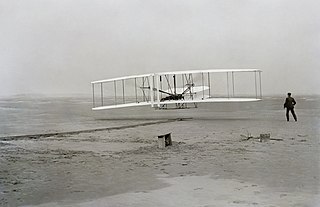
In aeronautical and naval engineering, pusher configuration is the term used to describe a drivetrain of air- or watercraft with propulsion device(s) after the engine(s). This is in contrast to the more conventional tractor configuration, which places them in front.

A bird strike is a collision between an airborne animal and a moving vehicle. The term is also used for bird deaths resulting from collisions with structures, such as power lines, towers and wind turbines.

The Xi'an MA60 is a turboprop-powered airliner produced by China's Xi'an Aircraft Industrial Corporation under the Aviation Industry Corporation of China (AVIC). The MA60 is a stretched version of the Xi'an Y7-200A, which was produced based on the An-24 to operate in rugged conditions with limited ground support and has short take-off and landing (STOL) capability.
A deadstick landing, also called a dead-stick landing or volplaning, is a type of forced landing when an aircraft loses all of its propulsive power and is forced to land. The "stick" does not refer to the flight controls, which in most aircraft are either fully or partially functional without engine power, but to the traditional wooden propeller, which without power would just be a "dead stick". When a pilot makes an emergency landing of an aircraft that has some or all of its propulsive power still available, the procedure is known as a precautionary landing.
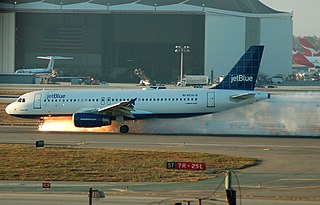
An emergency landing is a premature landing made by an aircraft in response to an emergency involving an imminent or ongoing threat to the safety and operation of the aircraft, or involving a sudden need for a passenger or crew on board to terminate the flight. It typically involves a forced diversion to the nearest or most suitable airport or airbase, or an off airport landing or ditching if the flight cannot reach an airfield. Flights under air traffic control will be given priority over all other aircraft operations upon the declaration of the emergency.

Qantas 1 was a Qantas passenger flight between Sydney and London. On 23 September 1999, the aircraft operating as Flight 1 had departed from Sydney that day, and was involved in a runway overrun accident at Don Mueang International Airport in Bangkok as it was landing for a stopover.
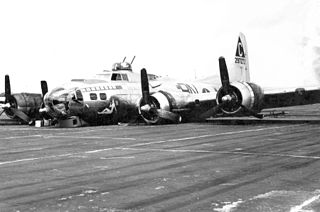
A belly landing or gear-up landing occurs when an aircraft lands without its landing gear fully extended and uses its underside, or belly, as its primary landing device. Normally the term gear-up landing refers to incidents in which the pilot forgets to extend the landing gear, while belly landing refers to incidents where a mechanical malfunction prevents the pilot from extending the landing gear.

P‑factor, also known as asymmetric blade effect and asymmetric disc effect, is an aerodynamic phenomenon experienced by a moving propeller, wherein the propeller's center of thrust moves off-center when the aircraft is at a high angle of attack. This shift in the location of the center of thrust will exert a yawing moment on the aircraft, causing it to yaw slightly to one side. A rudder input is required to counteract the yawing tendency.

Britannia Airways Flight 226A was an international passenger flight from Cardiff, Wales to Girona, Spain, operated by charter airliner Britannia Airways. On 14 September 1999, the Boeing 757-204 aircraft suffered a crash landing and broke apart during a thunderstorm in Girona-Costa Brava Airport. Of the 236 passengers and nine crew on board, two were seriously injured and 41 sustained minor injuries. One of the passengers who had apparently sustained only minor injuries died five days later of unsuspected internal injuries. The aircraft involved in the crash, Boeing 757-204 registration G-BYAG, was damaged beyond economical repair and scrapped.
Throughout a normal flight, a pilot controls an aircraft through the use of flight controls including maintaining straight and level flight, as well as turns, climbing, and descending. Some controls, such as a "yoke" or "stick" move and adjust the control surfaces which affects the aircraft's attitude in the three axes of pitch, roll, and yaw. Other controls include those for adjusting wing characteristics and those that control the power or thrust of the propulsion systems. The loss of primary control systems in any phase of flight is an emergency. Aircraft are not designed to be flown under such circumstances; however, some pilots faced with such an emergency have had limited success flying and landing aircraft with disabled controls.

On October 30, 2014, a Beechcraft King Air B200 twin turboprop crashed into a building hosting a FlightSafety International (FSI) training center shortly after taking off from Wichita Mid-Continent Airport in Wichita, Kansas. The pilot, the only person on board, was killed along with three people in the building; six more people in the building were injured.
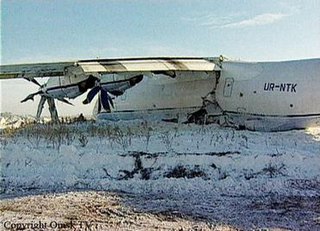
On 27 January 2001, an Antonov An-70 prototype crashed close to Omsk Tsentralny Airport, Russia during testing of the aircraft. All 33 passengers and crew on board the aircraft survived.

Reeve Aleutian Airways Flight 8 was an American domestic flight from Cold Bay, Alaska, to Seattle, Washington, on June 8, 1983. Shortly after takeoff, the Lockheed L-188 Electra of Reeve Aleutian Airways was travelling over the Pacific Ocean when one of the propellers broke away from its engine and struck the fuselage, damaging the flight controls. The pilots were able to make an emergency landing at Anchorage International Airport; none of the 15 passengers and crew on board were injured in the accident.
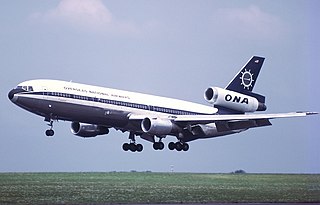
Overseas National Airways (ONA) Flight 032 was a non-scheduled positioning flight operated by Overseas National Airways with a McDonnell Douglas DC-10-30CF. On November 12, 1975, the flight crew initiated a rejected takeoff after accelerating through a large flock of gulls at John F. Kennedy International Airport, resulting in a runway excursion. Of the 139 aircraft occupants, all survived, while the aircraft was destroyed by an intense post-crash fire. The National Transportation Safety Board concluded that the probable cause of the accident was bird ingestion into the right-hand engine, causing an uncontained engine failure that ruptured several landing gear tires and disabled the engine's hydraulic system, in turn partially disabling the spoilers and the landing gear brakes. Contributing to the accident was the resultant failure of the affected engine's thrust reverser and the wet runway. The accident aircraft is claimed to be the largest commercial airliner ever destroyed due to a bird strike.

















